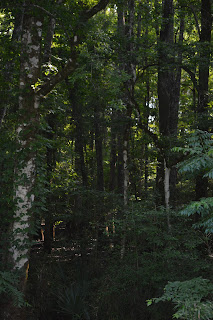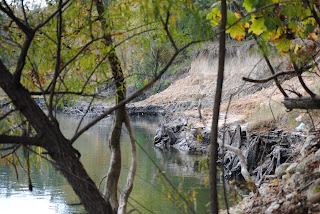 |
This rare 1849 $20 gold piece is at the National Museum of
American History. Could a treasure of similar coins worth
millions of dollars be hidden south of Grand Ridge, Florida?
National Numismatic Collection, National Museum of American History |
The end of the War Between the States (or Civil War) brought with it a time of hunger and starvation for people of all races in the rural counties of the Florida Panhandle. It was also a time when ruthless outlaws, many of them deserters from either the Union or Confederate army, stalked the roads and byways in search of plunder.
It was a time when anyone thought to possess gold or other valuables could quickly become the victim of a robbery or worse.
A man named S.D. Thom learned this deadly lesson on the night of September 2-3, 1865, when he set off from Ocheesee Landing in Calhoun County to meet up with a man named Luke Lott:
 |
Thom came ashore at Ocheesee Bluff in Calhoun County,
Florida. He traveled west from here to meet with Luke Lott. |
From a private letter, written from Chattahoochee on the 6th, we learn that Mr. S.D. Thom, a well-known citizen of Columbus, was found dead, on Sunday, Sept. 3d, on the road between Luke Lott's house and Gregory's saw-mill, in Jackson county, Fla., about fifteen miles from Ocheesee, with nine buckshot in his body. He was buried on the 4th. - Columbus Daily Enquirer, September 19, 1865.
Thom, as the above excerpt notes, was a prominent businessman in Columbus, Georgia. He had gone down the Chattahoochee River from that city in a small boat and stayed with a friend named A.D. Bull on the night of August 26th:
...[H]e showed a bag which he said contained $800 in gold, and told his host that he was going to see Mr. Luke Lott, whom he knew, and whom he had promised a visit, if he ever came to Florida, to buy bacon. He left the next morning in a bateaux, a negro being with him, for Lott's place. - Columbus Daily Enquirer, September 19, 1865.
 |
Calhoun County as it appeared in 1860
when it still extended all the way to the
Gulf of Mexico. Ocheesee is at the top left. |
The mention that Thom had gone to Florida to "buy bacon" means that he was planning to purchase a large supply of pork. He was engaged in business in Columbus and the amount would have been considerable.
Luke Lott, said by the article to have been an acquaintance of the murdered man, was a fascinating - and deadly - character.
He lived in northern Calhoun County between the Apalachicola and Chipola Rivers, but owned a large plantation that extended well into Jackson County. He had been successful and highly-regarded before and during the war, although there were also rumors that he had murdered one of his slaves. Lott was the captain of the Calhoun County Home Guard unit and military records indicate that he was a friend of Governor John Milton.
He was a pro-secession "fire eater" - to use the terminology of the day - and became a bitter enemy of the "Carpetbaggers" (Northerners who moved South) and "Scalawags" (Southern political allies of the Carpetbaggers) who controlled Florida during the Reconstruction era. He was, in fact, later accused of becoming an armed assassin.
...The report is that he went to Lott's deposited his money with him, remained a day or two, and was last seen with Lott, going towards Marianna to buy bacon. Report further says that Thom had deposited some $8,000 and $4,000 with Lott, but the writer is confident that he had not exceeding $400. Some friend should examine into the affair. - Columbus Daily Enquirer, September 19, 1865.
The reports of the time do not mention the exact location where Thom's body was found other than to note it was on the road between Luke Lott's home, in Calhoun County, and Gregory's Mill, in Jackson County.
 |
The beautiful old Gregory House at Torreya State Park was
the home of Jason Gregory, the builder of the mill mentioned
in the accounts of S.D. Thom's murder. |
Gregory's Mill had been built in around 1850 by Jason Gregory, a well-known resident of Ocheesee, It stood on the headwaters of Carpenter Sink Creek about 1.5 miles west of State Road 69 and about the same distance north of the Calhoun County line. Gregory is primarily remembered today as the builder of the beautiful old Gregory House that once stood at Ocheesee but now can be toured at Torreya State Park.
Lott lived almost due south of the mill in northern Calhoun County, although he had extensive land holdings throughout the area.
Civil law had broken down in the region by the end of the War Between the States, largely due to the capture or killing of so many local authorities during the Battle of Marianna. The U.S. military responded to the reports of the murder and an investigation of sorts followed:
We learn that Mr. LUKE LOTT, a citizen of Calhoun county, well known here, is under arrest in this city charged with the murder of Mr. THOM, of Columbus, Ga. Since his arrest a negro has been taken into custody for the same offence under suspicious circumstances. The case will be tried before a Military Commission. Mr. D.P. Holland is council for the accused. The case of Mr. Lott, we understand, is one of mere suspicion only. - Tallahassee Semi-Weekly Floridian, October 25, 1865.
 |
Jackson County as it appeared in 1888 (more or less!). The murder took
place south of Grand Ridge on the Calhoun County line. |
D.P. Holland, who served as Lott's attorney during his trial before the military tribunal in Tallahassee, had been a lieutenant colonel and later a colonel in the Confederate service. His legal expertise proved worthwhile and Lott was acquitted of the charges against him.
The fate of the African American man also charged with the crime is unknown. It is interesting to speculate whether he might have been the same man who accompanied S.D. Thom on his trip down the Chattahoochee River from Columbus, but this is not known with certainty.
The value of the stolen money is difficult to assess because so many different amounts were given by writers at the time. Gold was worth $30 per ounce in 1865 so a rough estimate, based on the range of values given for Thom's bag of coins, would be $16,738.05 to $503,400 at today's gold price of $1,258.50 per ounce.
This estimate is based strictly on the value of the gold itself and does not consider the value of 19th century gold coins to collectors! A single $20 Double Eagle gold piece from 1865 in excellent condition can be worth thousands of dollars today.
In other words, S.D. Thom's lost bag of gold could be worth millions.
The money was not recovered at the time of his murder and may still be out there today, buried somewhere near the line that divides Jackson and Calhoun Counties.








































